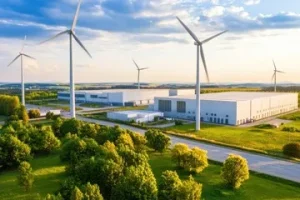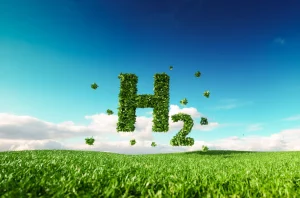Hydrogen Electrolysers in the Energy Sector: Accelerating the Transition to Renewable Power
A hydrogen electrolyser is a device that uses electricity to split water (H₂O) into hydrogen (H₂) and oxygen (O₂) through a process called electrolysis. Essentially, when an electric current is passed through water, the electrolyser separates the molecules into their basic elements—hydrogen collects at the cathode (negative electrode) and oxygen at the anode (positive electrode). The hydrogen produced is considered “green” if the electricity used comes from renewable sources like solar or wind, making it a key technology in the transition to cleaner energy. Electrolysers come in various types—such as alkaline, PEM (proton exchange membrane), and solid oxide—each with different efficiencies, costs, and operational requirements. People searching for hydrogen electrolysers are usually interested in how they can be used for sustainable fuel, energy storage, or industrial applications like ammonia production or steel manufacturing. It’s a growing field, especially with the global push towards decarbonization and energy independence.
In the global push toward decarbonization, hydrogen has emerged as a key player, especially when it’s green. The secret sauce? Hydrogen electrolysers. These high-tech systems are helping convert water into hydrogen and oxygen using clean electricity, offering a sustainable solution to cut dependence on fossil fuels and reshape the future of power.
As the energy sector hunts for innovative ways to integrate renewable energy sources and reduce greenhouse gas emissions, electrolysis technology stands out. From the proton exchange membrane (PEM) to solid oxide electrolysis cell (SOEC) systems, hydrogen electrolysers are not just buzzwords, they are tools of transformation.
In this blog, we will explore how hydrogen electrolysers work, the different types available, and why they are crucial to accelerating the shift toward renewable energy.

1. Types of Hydrogen Electrolysers
There are primarily three types of hydrogen electrolysers used in today’s energy sector, each suited for different applications and scales.
A. Proton Exchange Membrane (PEM) electrolysers
- These use a proton exchange membrane PEM to conduct protons from the anode to the cathode side while blocking electrons.
- They are capable of operating at high current densities and responding quickly to fluctuations in electricity supply, making them ideal for pairing with intermittent renewable energy sources like solar and wind.
- Highly efficient for green hydrogen production.
B. Alkaline electrolysers
- They use a liquid alkaline solution (typically potassium hydroxide) and allow negatively charged hydroxide ions to travel from cathode to anode.
- More established and cost-effective but less flexible than PEM systems.
C. Solid Oxide Electrolysis Cells (SOECs)
- SOECs operate at very high temperatures and use a solid ceramic electrolyte to conduct oxygen ions.
- These systems are particularly efficient when there’s access to waste heat, such as in industrial applications.
- A top contender for large-scale hydrogen production in integrated energy systems.
2. Why Hydrogen Electrolysers Are Crucial for Renewable Power
Hydrogen electrolysers act as enablers in the transition to clean energy in several ways:
a) Balancing Grid Demand
By converting surplus electricity into hydrogen during times of low demand, electrolysers help stabilize the grid and store energy that would otherwise be lost.
b) Decarbonising Industry
Hydrogen produced via electrolysis can replace carbon-intensive fuels in steelmaking, chemical production, and transportation—areas traditionally dependent on fossil fuels.
c) Facilitating Sector Coupling
Electrolysers bridge the power sector with heating, transportation, and industrial processes, accelerating system-wide decarbonisation.
3. Green Hydrogen Production: The Climate-Friendly Route
When powered by renewable energy sources, such as solar or wind, electrolysers produce what’s known as green hydrogen—a zero-emission fuel.
Unlike hydrogen produced from natural gas (grey hydrogen), or using carbon capture (blue hydrogen), green hydrogen avoids CO₂ emissions entirely. It simply takes electricity to split water into its basic components, delivering sustainable energy that can be stored, transported, or converted back into electricity using fuel cells.
The end product? Emission-free hydrogen is produced from a process that starts with a simple water molecule.
4. Challenges and Opportunities in Scaling Up
While promising, the widespread adoption of hydrogen electrolysers faces a few hurdles:
High Capital Costs:
PEM and SOEC technologies are expensive due to the materials and manufacturing processes involved.
Energy Efficiency Concerns:
Even though electrolysis is clean, it’s not always efficient. Energy losses occur at each stage, from converting power to hydrogen, and again when using fuel cells to convert hydrogen back to power.
Infrastructure Gaps:
From hydrogen storage tanks to refueling stations, infrastructure is still catching up to meet the demands of a hydrogen-powered economy.
That said, research and innovation in materials science, automation, and heat integration for solid oxide electrolysers are driving efficiency up and costs down.
5. The Road Ahead: Hydrogen Electrolysers in the Mainstream
Governments and energy companies are betting big on hydrogen. Initiatives like the EU’s Hydrogen Strategy and India’s National Green Hydrogen Mission are actively supporting the large-scale deployment of electrolyser projects.
With global investment surging, and commercial-scale hydrogen plants on the rise, the integration of hydrogen electrolysers into our renewable energy sources mix isn’t a matter of “if”, but “when”.
By converting electricity to split water in a clean and controllable manner, electrolysers offer unmatched flexibility. Whether it’s stabilising power grids, fueling industrial processes, or powering zero-emission vehicles, hydrogen is set to become the MVP of the clean energy transition.
Key Takeaway
Hydrogen electrolysers are not just another clean tech trend—they’re the beating heart of the energy transformation. From PEM electrolyser systems to solid oxide electrolysis cell SOEC innovations, they enable us to tap into the full potential of renewable energy sources by producing zero-emission hydrogen.
As infrastructure evolves and production scales up, hydrogen will unlock opportunities across transport, industry, and power sectors, making the goal of a net-zero planet truly achievable.
The hydrogen revolution is already here. Are you ready to join it?
Want to stay ahead in the green hydrogen game? Let Yonderh2 help you craft energy strategies, digital campaigns, or brand content that positions you as a clean energy leader. Reach out today—because the future waits for no one.
As the world moves towards a cleaner and more sustainable energy future, hydrogen electrolysers are playing a crucial role in the transition to renewable power. By producing green hydrogen through electrolysis, these systems enable industries and energy providers to decarbonize operations, reduce reliance on fossil fuels, and integrate renewable energy sources more effectively.
The Growing Importance of Hydrogen Electrolysers
Hydrogen electrolysis is a key technology in the shift toward a hydrogen-based economy. By splitting water into hydrogen and oxygen using electricity, hydrogen electrolysers provide a clean and scalable method of producing hydrogen fuel. When powered by renewable energy, this process results in zero carbon emissions, making it a vital component of global decarbonization efforts.
How Hydrogen Electrolysers Are Driving the Energy Transition
- Enabling Grid Stability and Energy Storage
Renewable energy sources like solar and wind are intermittent, leading to fluctuations in energy supply. Hydrogen electrolysers help mitigate this challenge by converting surplus electricity into hydrogen, which can be stored and later converted back into electricity when needed. This enhances grid stability and ensures a reliable energy supply.
- Decarbonizing Industrial Processes

Industries such as steel, cement, and chemical production are among the largest emitters of carbon dioxide. Hydrogen electrolysers provide a green alternative to fossil-fuel-based hydrogen production, significantly reducing emissions in these energy-intensive sectors.
- Powering Hydrogen Mobility and Transportation
The transportation sector is undergoing a major transformation with the adoption of hydrogen fuel cell vehicles. Hydrogen electrolysers enable on-site hydrogen production for refueling stations, supporting the widespread adoption of hydrogen-powered trucks, buses, and trains.
- Facilitating Green Ammonia and Synthetic Fuels
Hydrogen is a key ingredient in the production of green ammonia and synthetic fuels, which can be used as alternatives to traditional fossil fuels. Hydrogen electrolysers play a vital role in making these sustainable fuels viable for global energy markets.
The Future of Hydrogen Electrolysers in Renewable Energy
With declining costs and increasing policy support, hydrogen electrolysers are poised to become a cornerstone of the global energy landscape. Governments and private sectors are investing heavily in hydrogen infrastructure, paving the way for large-scale deployment of electrolysis technology.
YonderH2: Enabling the Hydrogen Revolution
At YonderH2, we manufacture high-efficiency DC power sources and rectifiers that support hydrogen electrolyser operations. Our reliable power solutions ensure stable and optimized hydrogen production, accelerating the transition to renewable energy.
Visit https://yonderh2.com to explore our offerings and learn how we contribute to the global hydrogen economy.





